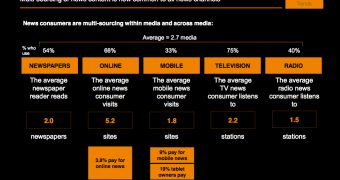When it comes to news, the web is an important source, but it's not the biggest one, at least not in the UK. TV still takes the crown, but the gap is getting smaller. In fact, given the current trends, the web will become the primary source of news for most people within a couple of years.
The Oliver & Ohlbaum consultancy has released the results of its annual survey. It found that 75 percent of those asked got their news from TV. However, most people had more than one sources of information.
In fact, the average was 2.7 media sources, i.e. places where they found news. Most people use at least two sources and many of them use three different sources for their news.
Outside of TV and the web, which was used by 68 percent of respondents, 54 percent read news in newspapers, 40 percent listened to the radio and 33 percent got them on their mobile devices.
Also interesting is the number of individual sources that users consult from a single medium. For example, most people only get their news from 2.2 TV stations. Online though, they're more spread out and use 5.2 sites on average.
Those that prefer newspapers read two of them, while people visited only 1.8 mobile news sites on average and listened to only 1.5 radio stations.
A big topic for publishers, especially with the big move online and more recently to mobile devices, is how many people pay directly for their news.
The survey found that only 3.8 percent of web users pay for news, but nine percent of mobile users do. What's more, 19 percent, almost one in five tablet owners pay for news. It's unclear whether that's via apps or website subscriptions, but it's still a big number.

 14 DAY TRIAL //
14 DAY TRIAL //